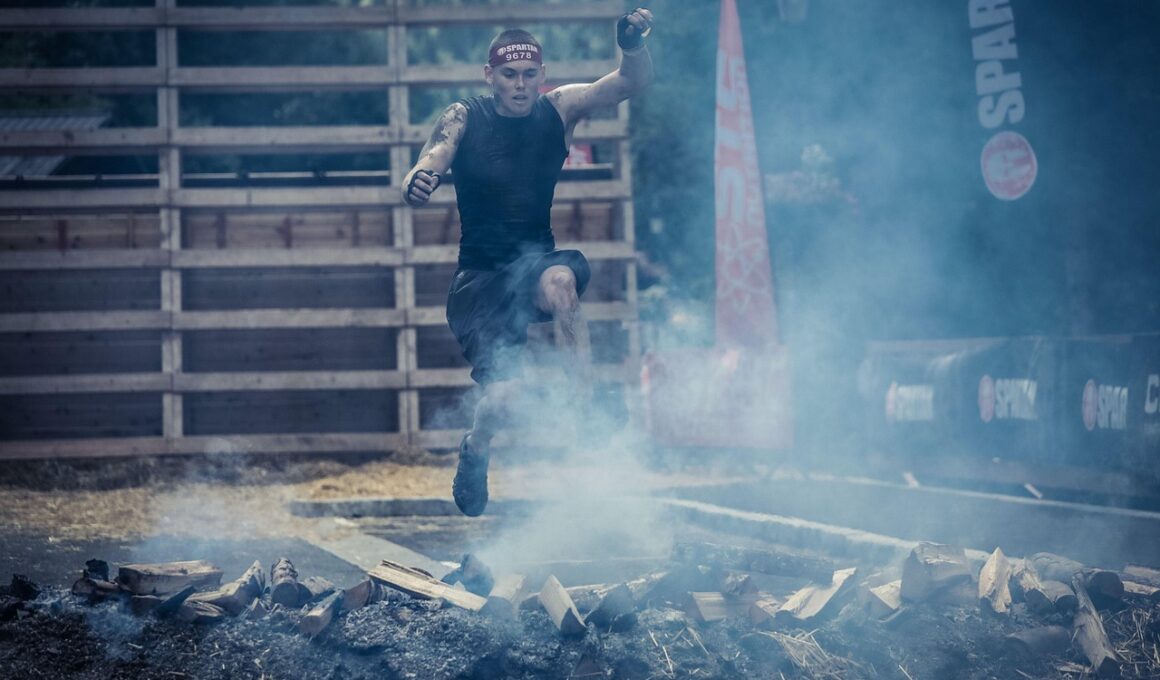Combining Outdoor Obstacle Course Training with Cardiovascular Workouts
Outdoor Obstacle Course Training has gained immense popularity, thanks to its exciting and diverse nature. It allows individuals to experience physical challenges that break the monotony of traditional workouts. This form of training enhances strength, agility, and cardiovascular fitness required for various physical activities. Typical courses comprise various stations such as crawl spaces, monkey bars, and balance beams. These obstacles create an engaging experience, drawing both beginners and advanced trainees alike. The constant changes in movement patterns stimulate the heart, making it a great cardiovascular workout as well. As you navigate the course, your heart rate elevates, promoting endurance while working different muscle groups. Training outdoors can also have psychological benefits, reducing stress and enabling better mood regulation. The fresh air and natural surroundings contribute to a more enjoyable workout, keeping individuals motivated to return. Many find that the combination of navigating barriers and sustaining cardio boosts not only physical performance but also mental resilience. To further enhance your training, consider integrating interval training by alternating between high-intensity obstacles and slower-paced recovery periods. This will optimize calorie burning while providing a structured approach.
Benefits of Combining Training Styles
The combination of outdoor obstacle training and cardiovascular workouts brings unique benefits. First, you engage in total body workouts, actively utilizing multiple muscle groups simultaneously. Enhanced coordination and balance emerge from navigating obstacles, helping prevent injuries in daily activities. Furthermore, outdoor environments contribute to variability, as surfaces change and allow for functional movement skills. This adaptability means your body constantly challenges itself, leading to improvements in physical performance. Cardiovascular fitness is another critical advantage gained through this unique training method. By elevating your heart rate consistently during workouts, you boost endurance levels necessary for both obstacle course racing and daily life. This form of training can stimulate metabolic responses, enhancing your body’s ability to torch calories effectively. Engaging with others in group obstacle courses promotes camaraderie and friendly competition, encouraging a sense of community. Such social interaction can improve adherence to training programs, keeping participants more committed. Additionally, the mental boost acquired from conquering obstacles translates to confidence, positively influencing everyday life. Ultimately, mixing these workout styles creates an enjoyable regimen that addresses fitness holistically, blending strength, endurance, and mental resilience.
Designing Your Outdoor Obstacle Course
Designing your outdoor obstacle course is essential to maximize the benefits of combined training. Start by assessing your available outdoor space, as this will determine what types of obstacles you can install. Aim for a variety of stations that enhance both strength and cardiovascular exertion. For instance, incorporate climbing walls and tire flips for strength, and include hurdles and sprint tracks to increase heart rates. Ensure that each station targets different muscle groups, facilitating a well-rounded workout routine. Another factor to consider is the height and complexity of obstacles; tailor these to cater to various fitness levels. Safety should always be a priority, utilizing materials that can withstand weather conditions and impact. To keep it engaging, incorporate exercises like burpees or jumping jacks between obstacle stations, promoting both strength and cardio. Adding elements like climbing ropes or agility ladders can create a challenging and skills-based environment. Finally, consider scheduling training sessions or group challenges, allowing for friendly competition and social engagement. This not only motivates participants but also fosters a sense of community, enhancing the overall experience while pushing fitness limits.
Focusing on progress and maintaining a growth mindset within outdoor obstacle training is vital to achieving long-term goals. Set realistic and achievable targets that keep pace with skill developments. Measurement of progress can be done by tracking completion times, evaluating the number of repetitions, or assessing how quickly participants navigate the course. Monitoring improvement helps foster motivation and encourages individuals to push beyond their comfort zone, enhancing the workout experience further. Additionally, ensure that you celebrate personal achievements, no matter how small they may seem. Small victories create a sense of accomplishment and drive participants to continue their fitness journey. Another essential aspect of training progress is adaptability; regularly update the obstacles and incorporate new challenges. This variability keeps fitness enthusiasts engaged and eager to return. Combining new elements will prevent plateaus while optimizing performance enhancement. Encourage feedback from participants, which will improve course design and boost the overall experience. Furthermore, consider organizing outdoor obstacle challenge events for additional motivation and engagement. These events foster community spirit while rewarding physical achievement, further cementing the outdoor obstacle training culture.
Nutrition for Optimal Performance
Alongside outdoor obstacle training, nutrition plays a crucial role in optimizing performance. Consuming a balanced diet featuring essential nutrients fuels the body effectively to endure vigorous physical activity. Prioritize adequate protein intake to aid muscle repair and growth after strenuous workouts. Sources like lean meats, legumes, and dairy products are excellent choices. Carbohydrates also serve as a primary energy source, meaning complex carbs should be central to your meals. Foods such as whole grains, fruits, and vegetables ensure sustained energy levels. Hydration is another cornerstone for performance, as even mild dehydration can hinder workout efficiency and recovery. Ensure fluid intake before, during, and after training sessions to keep the body adequately hydrated. Incorporating healthy fats, like those found in avocados and nuts, can provide additional energy resources and support overall well-being. Consider planning meals around your training schedule, allowing for energy optimization prior to workouts. Post-workout snacks rich in protein and carbohydrates facilitate quick recovery, essential when training outdoors. Investing time in meal planning not only enhances performance but also fosters a routine promoting better health and fitness sustainability over time.
Additionally, integrating technology into your outdoor workouts can enhance both training experience and results. Fitness apps offer tracking capabilities to monitor heart rate, distance, and calories burned during obstacle courses. Utilizing this data allows participants to foster awareness of their physical exertion and recovery patterns. Many wearable devices can provide real-time feedback and reminders to keep on track with training goals. Some applications even allow for virtual participation in obstacle challenges, integrating a sense of competition and progress tracking. Furthermore, accessing fitness social networks can build motivation through shared commitments and achievements. Engaging with a community through online platforms ensures continued knowledge sharing, advice, and support. Explore online classes or challenges that fit into your training regimen, such as virtual obstacle races or boot camp workouts. Each participant can access an extensive network of resources, tips, and workout plans. Ultimately, technology adds another layer of engagement to outdoor obstacle course training while fostering camaraderie among fitness enthusiasts. This blend of traditional training methods with modern technology continues to revolutionize the way individuals approach fitness, making it both enjoyable and effective.
Lastly, embracing a holistic approach to outdoor obstacle course training can significantly boost overall fitness. This means incorporating recovery techniques and mindfulness alongside regular workouts. Practices such as yoga and meditation enhance flexibility, reduce injury risk, and build emotional resilience. Allowing for active recovery days can improve performance during high-intensity obstacle training, as well. Use these days to engage in low-impact activities like walking or swimming, minimizing burnout while ensuring consistent fitness progress. Implementing stretching routines post-training not only aids recovery but promotes flexibility. Engage in deep breathing exercises to center your mind and enhance focus before and after workouts. Additionally, prioritizing sleep is essential, as it provides the body ample time to repair from extensive training. Schedule sufficient downtime to recover both physically and mentally for optimal performance. Combine these elements of holistic wellness with outdoor obstacle training to optimize the physical, emotional, and mental aspects of fitness. This integrative approach ensures that participants can thrive inside and outside obstacle courses, fostering a well-rounded and accomplished fitness journey.
Conclusion
In conclusion, combining outdoor obstacle course training with cardiovascular workouts creates an exhilarating fitness experience. The multifaceted benefits, ranging from improved physical performance to enhanced mental resilience, make this approach particularly appealing. By creating engaging and challenging courses, fitness enthusiasts optimize not only strength and endurance but also camaraderie and motivation. The journey of integrating unique training methods inspires individuals to connect with nature while fostering community spirit. Taking a holistic approach that incorporates nutrition, recovery, and technology ensures that practitioners continuously strive for progress and improvement. This keeps participants focused and committed while demonstrating the true power of outdoor workouts. With advancements in health and fitness methodologies, outdoor obstacle course training remains a popular choice among fitness lovers. Its diversity, challenge, and capacity for fostering personal connections set it apart from conventional training styles. As you embark on your own outdoor obstacle course journey, embrace the myriad opportunities for personal growth, fitness enhancement, and joyful engagement with the world around you. The combination of strength, cardio, and community provides an ideal foundation for healthy living, empowering you to achieve your unique fitness goals.


